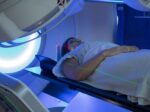If you’ve been diagnosed with prostate cancer, you will be under the care of a specialist team of healthcare professionals who will determine the most appropriate treatment plan for your condition. Throughout treatment, you will be regularly monitored.
Active surveillance is a monitoring process for prostate cancer that does not involve immediate treatment as this may not be needed. It is typically recommended for men with low-risk prostate cancer that has not spread beyond the prostate. Low-risk prostate cancer is characterised by a PSA (prostate-specific antigen) blood level of less than 10, a Gleason score of up to 3 + 3, and a clinical stage of T1‒T2a (confined to the prostate).
Prostate cancer can be monitored through ‘active surveillance’ or observation, also known as watchful waiting. Active surveillance involves regularly monitoring the cancer’s current status and whether it is progressing, and initiating treatment if tests indicate accelerated growth. Observation is a more relaxed approach, focusing primarily on tumour changes to determine if and when treatment is necessary.
Tests that may indicate whether the prostate cancer is progressing or growing will be conducted by your GP or urologist. These tests may include a PSA (prostate-specific antigen) blood test approximately every six months and a DRE (digital rectal examination) typically once a year.
Should prostate cancer be treated immediately?
Low-risk prostate cancer usually does not need to be treated straight away. In fact, for some patients, treatment may not be needed for up to a decade or more, and doctors alternatively recommend active surveillance.
This is because prostate cancer judged to be low risk may not progress or cause problems, so having treatment may be unnecessarily intrusive, causing unwanted side effects. Many men with low-risk prostate cancer live with it for long periods of time with no impact on their life or health.
Active surveillance involves regular follow-up blood tests, rectal exams, and prostate biopsies if needed – all of which help in monitoring the progression of the cancer. If tests indicate that the cancer is spreading or progressing, patients may opt for cancer treatment such as surgery or radiotherapy, including proton beam therapy (PBT).
Some research studies suggest, including this one, indicate patients can delay prostate cancer treatment safely for several years if it is confined to the prostate and low-risk.
What is active surveillance?
While we discussed active surveillance for prostate cancer briefly in the beginning, it’s really worth understanding what it is and how patients can benefit in a bit more depth and detail.
When someone is diagnosed with localised prostate cancer—meaning that the cancer hasn’t spread beyond the prostate or to nearby sites such as seminal vesicles or lymph nodes, or more distantly to bones—certain types of disease management may be used to monitor the cancer’s progression.
So, if you have low-risk, non-growing or slow-growth prostate cancer which is confined only to the prostate gland, you might be recommended and wish to consider ‘active surveillance’.
The process involves monitoring the prostate cancer while it is still in an early localised stage until your physician or doctor believes that further treatment is required in order to halt the cancer growth while it is still at a curable stage.
Active surveillance is regularly recommended in patients where:
- The cancer is confined to the prostate only
- The tumour is small and expected to grow only slowly if at all
- The patient is not experiencing any symptoms of prostate cancer spreading locally outside the prostate (for example, difficulty passing urine)
- The patient can continue to live a normal life with prostate cancer without it affecting his quality of life
- The patient values short-term quality of life over long-term consequences which may occur due to not getting immediate treatment (surgery or radiation therapy)
- The patient has a low risk cancer and prefers to avoid the side effects of potentially unnecessary treatments (surgery and radiotherapy)
Why is active surveillance used for monitoring prostate cancer?
Certain kinds of prostate cancers are slow growing or may not grow at all, and may not cause any major health problems or affect your quality of life significantly.
Cancer treatments of all kinds tend to have side effects and, for some people, more so than others. Active surveillance helps to ensure that you don’t end up getting prostate cancer treatment that you don’t require.
Regular tests as part of active surveillance ensure that your doctor is always fully informed as to whether your prostate cancer is the same size or starting to progress. Treatment is, therefore, only given if there are any signs pointing to the fact that the cancer is changing or growing.
What happens if you notice abnormalities from active surveillance?
If active surveillance test results indicate that the cancer cells are growing, your doctor will need to determine the aggressiveness or ‘grade’ of that growth. He/she will arrange for a biopsy, a sample of your cancer cells in order to determine how much the cancer cells have progressed – i.e. how different they are compared to healthy cells.
So, a higher grade will indicate a more aggressive cancer, which means active treatment options should be considered, as the cancer could spread locally or distantly if left untreated.
Once abnormalities have been discovered through active surveillance, your doctor will either use the Gleason score or genomic testing to determine the grade of the cancer.
The Gleason score is the most common scale used for evaluating the grade of prostate cancer cells in a biopsy, with numbers ranging between 2 (non-aggressive) and 10 (very aggressive). However, the lower part of the range is not used very often. Therefore, a score of 6 or less would indicate a low-grade prostate cancer, while 7 would indicate medium-grade prostate cancer, and 8-10 would indicate high-grade prostate cancer.
Genomic testing is a process through which prostate cancer cells are studied to understand the gene mutations within them. This test can provide more information about the aggressiveness of the cancer. Genomic tests are not very widely used or available and indeed may not even be necessary for every person with prostate cancer. However, the additional information that they provide may to help doctors make more informed treatment decisions under specific circumstances.
Following the prostate cancer diagnosis, your doctor may use any of the following diagnostic tests to determine how far the cancer has spread from your prostate, if at all:
- CT (Computerised Tomography) scan
- MRI (Magnetic Resonance Imaging) scan
- PET (Position Emission Tomography) scan
- Ultrasound scan
- Bone scan
Getting a second opinion after spotting that prostate cancer is growing
Patients can seek a second opinion before beginning treatment for prostate cancer. This can be useful in a number of ways:
Having a second doctor review your diagnosis and proposed treatment plan can ensure that you get the right treatment, particularly if you see a prostate cancer specialist in a major and reputable cancer care centre.
Seeking a second opinion may also allow you to consider alternative treatment options which may not have been offered to you previously.
Being diagnosed with prostate cancer may make you feel that you need to act immediately, but it’s really worth taking a moment to consider everything you’ve been told and get thoughts as well as opinions from a second expert.
After all, when it comes to your health, wellbeing, and quality of life, it is important to gather as much information as possible.
Can those who are using the active surveillance method start proton beam therapy?
Active surveillance is generally recommended to those who have low risk prostate cancer in the early stages, that is, the cancer is confined to the prostate and has not shown any signs of progressing to other parts of the body (such as the bones and/or lymph nodes).
While proton beam therapy is generally used to treat more aggressive forms of prostate cancer, it may be used in some instances to prevent low risk prostate cancer from progressing. However, it is important to understand that most patients on active surveillance have enjoyed the same or better quality of life compared with those undergoing treatment such as surgery or radiotherapy.
it is important to understand that each patient with prostate cancer is different and unique. Your consultant oncologist will carefully assess your prostate cancer to determine if you may be eligible for proton beam therapy.
Contact Proton International London
Proton International London is the first private proton beam therapy facility in London and is run by a dedicated private proton beam therapy team at UCLH.
Our parent company Proton International has over 30 years’ experience in treating cancer patients in the USA, and now brings its extensive expertise and experience to London, providing this highly accurate and effective treatment to people with cancer, whether they reside in the UK or are travelling from overseas for treatment.
Alongside offering the highest quality of service and care possible with a “patient first” approach, each patient’s health and wellbeing are among the core pillars of PIL, supporting them on a personal level throughout their journey.
Contact us now to understand your suitability for proton beam therapy, and to arrange an initial consultation.
Frequently asked questions about active surveillance
To learn more about active surveillance and how to access proton beam therapy, read our FAQs below or contact us today:
What if my doctor doesn’t talk about proton therapy as a prostate cancer treatment?
Depending on your individual circumstances, the aggressiveness of your prostate cancer, and the level of treatment required, your doctor may or may not recommend PBT for prostate cancer treatment.
The expert radiation oncologists at Proton International London will take the time to discuss all the available options, including proton beam therapy. Factors that help to determine if PBT is suitable as treatment for your prostate cancer can include your age and general health, as well as the tumour’s location, grading and signs of progression.
Further reading:





